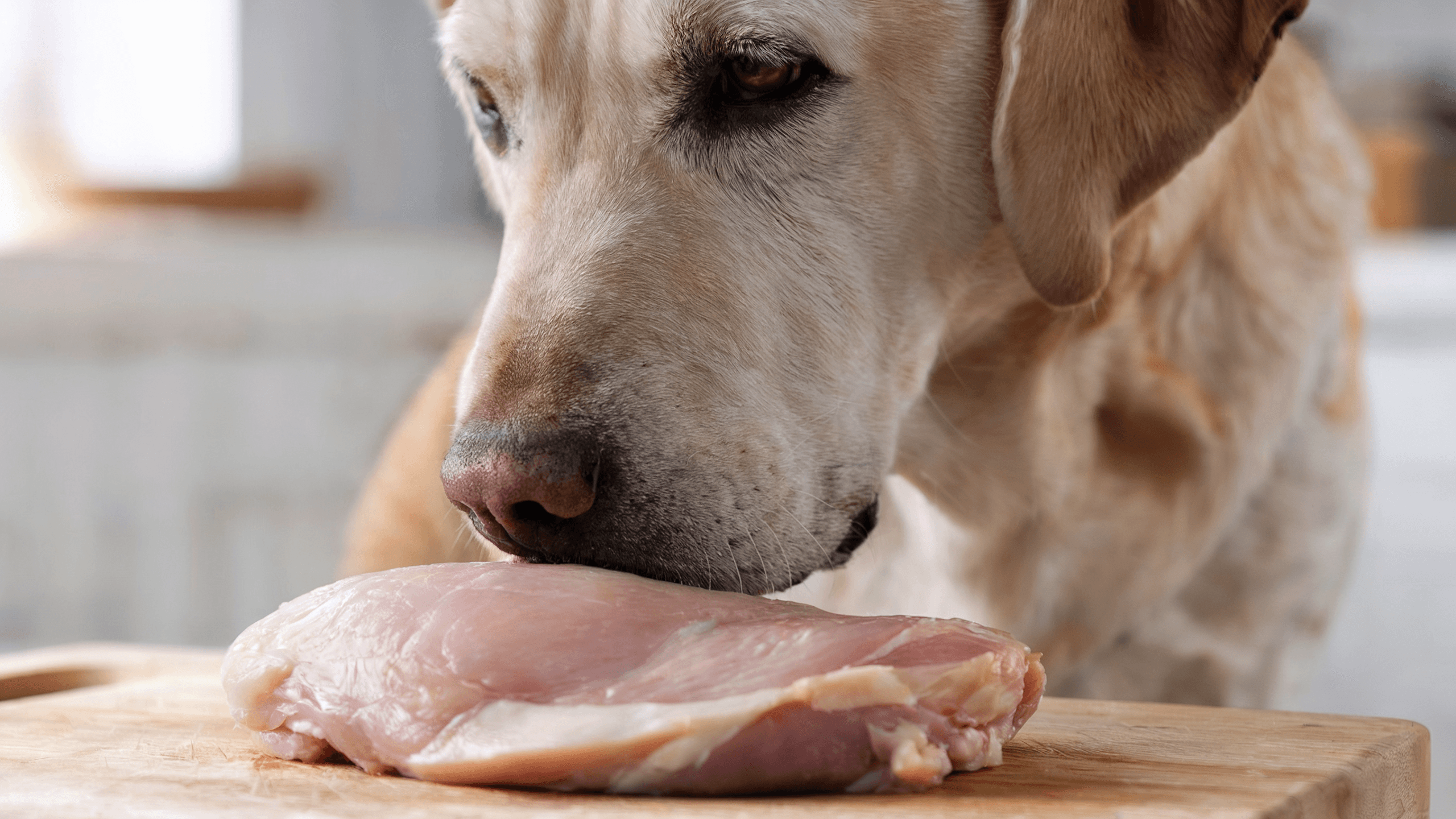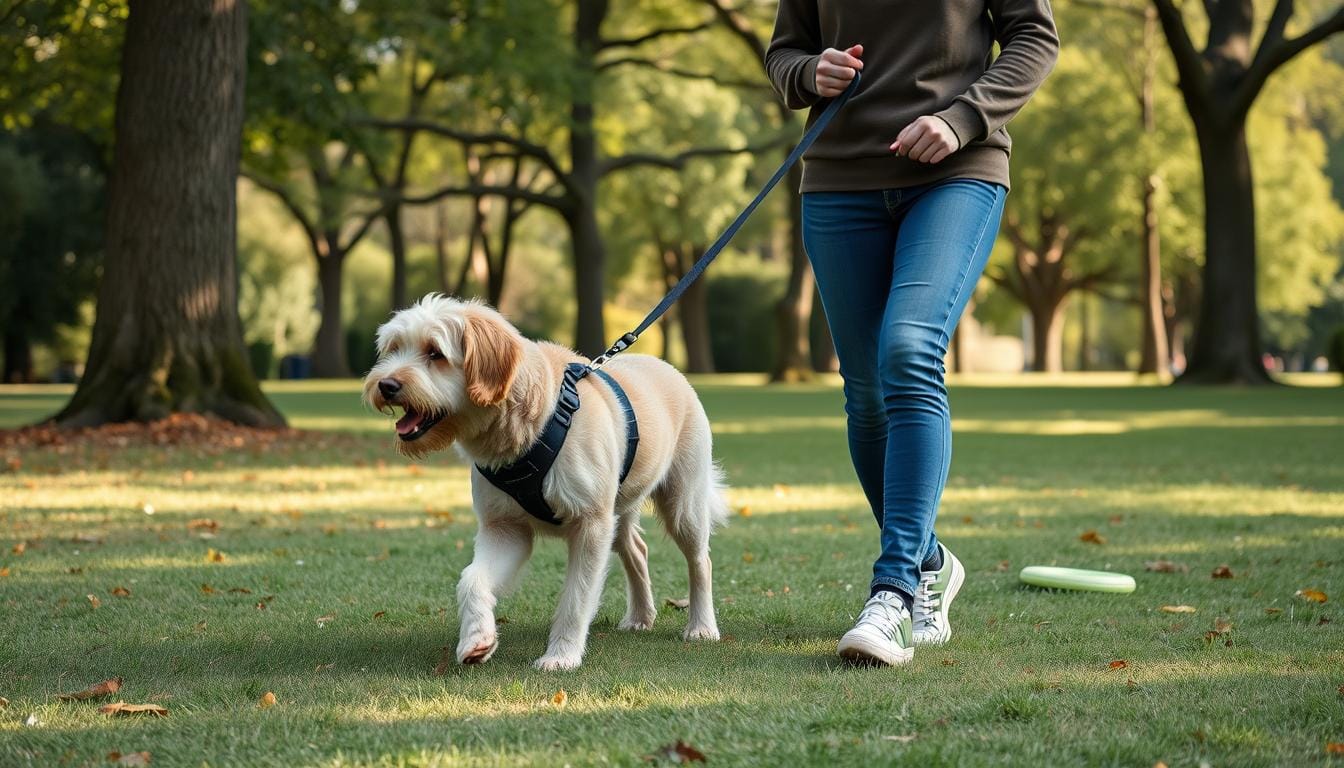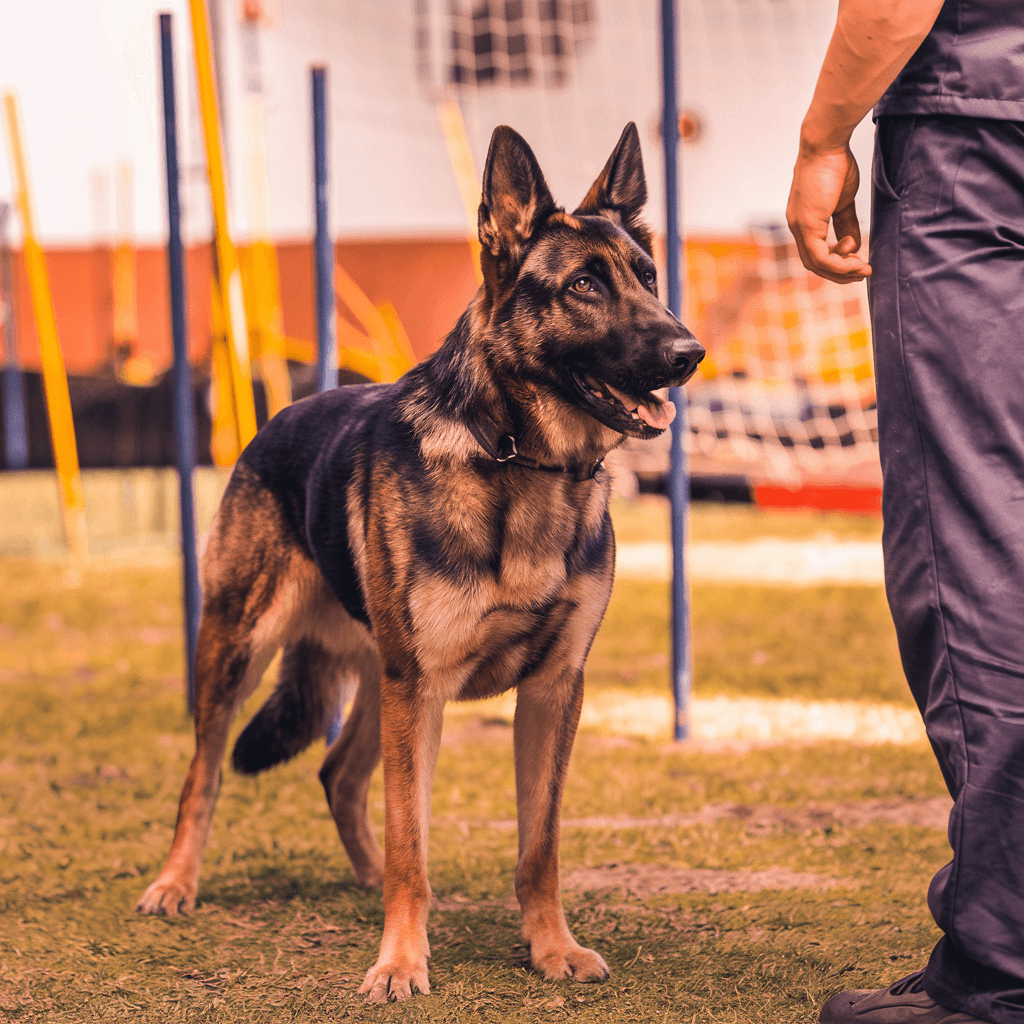Dogs can sense human emotions instinctively. They read our facial expressions and body language. This emotional intelligence helps them form deep bonds with us.
Dogs can comfort us when we’re sad or share our joy. This skill shows the complex relationship we share with dogs. Let’s explore the fascinating world of canine diet and nutrition, starting with raw chicken for dogs.
Key Takeaways
- Dogs have a unique ability to sense and respond to human emotions.
- Raw chicken in a dog’s diet is a controversial topic with both potential benefits and risks.
- The safety of feeding raw chicken to dogs depends on factors like meat quality and proper handling.
- Some studies suggest raw diets can improve coat health and dental hygiene in dogs.
- Experts emphasize the importance of balanced nutrition when considering raw food for dogs.
Raw chicken as part of a canine diet has sparked debate. Some believe in its benefits, while others warn of risks. Let’s examine the pros and cons of feeding raw chicken to dogs.
Recent studies have shown potential benefits of raw diets for dogs. Dogs on raw meat diets often have healthier coats and skin. Raw meat options can also improve dogs’ oral health, removing up to 95% of dental calculus.
However, the American Veterinary Medical Association (AVMA) has concerns. They worry about the lack of regulatory oversight for raw pet foods. This could lead to unbalanced formulas that might harm a dog’s health over time. It’s crucial to weigh these factors carefully when considering raw chicken for your furry friend.
As we explore this topic further, we’ll delve into the nitty-gritty of canine nutrition, safety considerations, and expert opinions. By the end, you’ll have a clearer picture of whether raw chicken might be a good fit for your dog’s diet. Let’s continue our journey into the world of canine nutrition!
Understanding the Raw Food Diet for Dogs
The raw food diet for dogs is becoming more popular. Pet owners want natural nutrition for their pets. This diet is based on what wild canines eat, using unprocessed ingredients.
The BARF Diet: Origins and Principles
The BARF diet, or Biologically Appropriate Raw Food, started in 1993. It includes raw meat, bones, fruits, and veggies. It’s based on what wild canines eat.
People say dogs are almost as similar to wolves as humans are to chimpanzees. This makes them good at eating raw chicken.
Evolution of Canine Dietary Needs
Dogs and wolves share a common ancestor. But, dogs have changed a lot since they started living with humans. They can now eat many different foods, including some starchy ones.
This change has led to debates about what’s best for dogs to eat. You can read more about this here.
Raw vs. Commercial Dog Food
Choosing between raw dog food and commercial kibble is hard. Raw food gives dogs whole foods without fillers. Kibble is convenient but has processed ingredients.
Let’s look at the differences:
| Aspect | Raw Dog Food | Commercial Kibble |
|---|---|---|
| Ingredients | Whole meats, organs, bones | Processed meats, by-products, fillers |
| Nutritional Value | High in natural nutrients | Fortified with synthetic vitamins |
| Cost | Generally more expensive | Often more affordable |
| Convenience | Requires preparation | Ready to serve |
| Safety Concerns | Potential bacterial risks | Lower risk of contamination |
Raw diets are natural but need careful handling. They might be risky. Commercial foods are easy to use but have processed ingredients. It’s important to think about your dog’s needs and talk to a vet before changing their diet.
Potential Benefits of Raw Chicken for Dogs
Raw chicken benefits have caught the eye of dog owners wanting to boost their pet’s health. Some studies suggest raw diets might be good for dogs’ health, despite controversy.

Feeding dogs raw chicken can make their coats shinier and healthier. Studies show dogs on raw diets have better coat texture. This is because raw meat is full of nutrients.
Raw chicken might also help with joint health. Chicken cartilage has glucosamine and chondroitin, which support joints. Omega-3 fatty acids in raw chicken can reduce inflammation, helping joints stay healthy.
Some believe raw feeding improves digestion. They say unprocessed meat is easier for dogs to digest, leading to better nutrient absorption and less smelly stools. Dogs on raw diets might also have fewer allergies and food sensitivities, as commercial dog foods often contain allergens.
- Improved coat condition
- Enhanced joint health
- Better digestion
- Reduced food sensitivities
Dental health could also benefit from raw diets. Studies suggest raw bones can cut down dental calculus and freshen breath. This helps keep dogs’ mouths clean.
However, it’s important to remember the risks of raw chicken. The American Veterinary Medical Association warns against raw diets because of bacterial contamination. Always talk to a vet before changing your dog’s diet.
Can Dogs Eat Raw Chicken: Safety Considerations
When it comes to dog food safety, raw chicken is a big concern. Many healthy dogs can eat it without problems. But, it’s important to know the risks.
Bacterial Risks: Salmonella and Others
Raw chicken can be contaminated with Salmonella. Dogs might not get sick as easily as humans, but it’s still a risk. Freezing the chicken can lower the risk, but it doesn’t get rid of it completely.
Choking Hazards and Bone Fragments
Raw chicken bones can be a choking hazard. Raw chicken necks can clean your dog’s teeth, but be careful of small bones. Always watch your dog when they eat raw chicken to avoid choking.
Nutritional Imbalances
Eating only raw chicken can cause nutritional problems. Different parts of the chicken have different nutrients:
- Raw chicken breast: Low in fat, great protein source
- Raw chicken livers: Full of Vitamin A
- Raw chicken feet: Good for teeth
To make sure your dog gets all the nutrients they need, mix raw chicken with other foods. Brands like Natures Menu make raw food for dogs, making it a safer choice.
| Chicken Part | Nutritional Benefit | Consideration |
|---|---|---|
| Breast | High protein, low fat | Safe for most dogs |
| Liver | Rich in Vitamin A | Feed in moderation |
| Feet | Supports oral health | Monitor for choking |
| Skin | High in fat | Feed sparingly |
While raw chicken is good for many dogs, it’s not for everyone. Dogs with health issues or allergies might not be able to eat it. Always talk to a vet before changing your dog’s diet.
The Canine Digestive System and Raw Meat
Dogs have a special digestive system for raw meat. Their short digestive tract and acidic stomach help a lot. This makes them good at breaking down proteins from raw meat.

More dogs are eating raw meat now. About 15% to 25% of dogs have raw meat in their diet. This has made raw pet food sales grow by at least 15% every year.
Eating raw meat can be good for dogs. Raw diets have more antioxidants like vitamins C and E. Some owners see better immune function and weight control in their dogs.
But, not all dogs do well with raw meat. Age, health, and breed matter. Older dogs, puppies, or dogs with weak immune systems might have tummy troubles.
“Raw diets can be beneficial for pets with food allergies, helping to manage conditions like vomiting, diarrhea, ear infections, and itching.”
Many dogs can eat raw chicken just fine. But, cooked chicken is safer because it kills harmful bacteria. Always talk to a vet before adding raw meat to your dog’s diet. This ensures it’s right for your pet’s health and needs.
Quality Matters: Choosing Safe Raw Chicken for Dogs
Feeding our dogs raw chicken requires careful attention to quality. We must choose safe raw chicken to protect their health. Let’s learn how to pick and prepare the best chicken for our pets.
Sourcing High-Quality Chicken
Finding the best chicken is key for dog food preparation. Look for pasture-raised chickens without antibiotics or hormones. These chickens are often more nutritious and cleaner.
Proper Handling and Storage
Keeping meat safe starts with how we handle it. Always freeze raw chicken until you’re ready to use it. Thaw it in the fridge. Use different cutting boards and tools for raw meat to avoid contamination.
Preparing Raw Chicken for Dogs
When preparing raw chicken, take out the bones to avoid choking. Cut the meat into sizes that fit your dog. Some owners add salmon oil for extra nutrition.
| Aspect | Recommendation |
|---|---|
| Chicken Source | Pasture-raised, non-GMO |
| Storage | Frozen until use |
| Preparation | Remove bones, cut to size |
| Supplements | Consider adding salmon oil |
While raw chicken can be good for coat health and allergies, talk to a vet first. They can help make sure it’s right for your dog. They’ll guide you on how to feed raw chicken safely.
Impact of Raw Chicken on Canine Health
Feeding raw chicken to dogs is a topic of ongoing research. It can lead to several positive health outcomes. Dogs have short digestive tracts and acidic stomachs, making them good at digesting raw meat.
Raw chicken can improve a dog’s coat health. Studies from The University of California, Davis show that raw meat makes coats glossier and more lustrous. It may also help with joint health, thanks to the glucosamine and chondroitin in chicken cartilage.
Raw chicken contains omega-3 fatty acids, which are anti-inflammatory. This can help with joint health. Many dog owners notice their pets have less smelly and less frequent stools on a raw diet. Some dogs also see relief from allergies and food sensitivities found in processed foods.
| Health Aspect | Potential Benefit |
|---|---|
| Coat Health | Improved luster and texture |
| Joint Health | Support from glucosamine and chondroitin |
| Digestion | Easier digestion, less frequent stools |
| Allergies | Potential relief from food sensitivities |
| Oral Health | Better oral hygiene, fresher breath |
While the benefits are promising, there are risks to consider. Raw chicken can carry bacteria like salmonella. However, dogs are less likely to get sick from these than humans. It’s important to have regular vet visits and blood work to keep an eye on your dog’s health on a raw diet.
Transitioning Your Dog to a Raw Chicken Diet
Changing to a raw diet is a big step for your dog. We’ll help you through the transition smoothly.
Gradual Introduction Methods
Begin by adding a little raw chicken to your dog’s food. Gradually increase the amount over time. This helps your dog adjust without upset stomachs.
- Week 1: 25% raw, 75% current food
- Week 2: 50% raw, 50% current food
- Week 3: 75% raw, 25% current food
- Week 4: 100% raw diet
Monitoring Your Dog’s Response
Watch your dog closely during the transition. Look for signs of upset stomachs or allergies. Good signs include more energy and a better coat. If you see any issues, slow down the transition.
When to Consult a Veterinarian
It’s important to talk to a vet before big diet changes. This is especially true for puppies, older dogs, or those with health issues. Your vet can give advice tailored to your dog’s needs.
Every dog is different. Some may quickly get used to raw chicken, while others need more time. Be patient and keep a close eye on your dog for a successful transition.
Alternative Protein Sources in Raw Diets
Raw diet variety is key for your dog’s health. While chicken is common, other proteins can be better. Raw beef is rich in iron, fish gives omega-3 for a shiny coat, and lamb is great for sensitive dogs.
Darwin’s Pet stresses the need to mix proteins. This keeps your dog’s diet balanced and prevents allergies. Each protein adds something special to your dog’s meals.
Introduce new proteins slowly. Start with a little and watch how your dog reacts. Talk to your vet about the right amount for your dog’s age and activity. A varied raw diet can boost your dog’s health and energy.
















